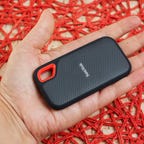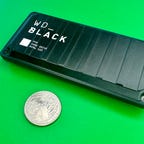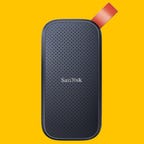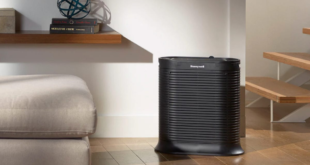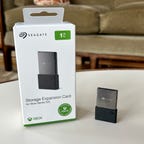
Best for expanding storage for Xbox Series X/S games
Seagate Storage Expansion Card
View details
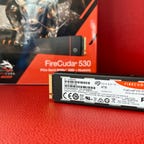
Best for expanding storage for PS5 games
Seagate FireCuda 530 with Heatsink
View details
Rugged workhorse external hard drive
LaCie Rugged USB-C 5TB Portable HDD
View details
What’s the best external drive?
Whether it’s family photos or work projects, running out of internal storage on your devices happens quickly. Luckily, all you have to do to free up space is buy an external hard drive or solid state drive (SSD). We tested external hard drives and found the best storage devices at a competitive price for all your external storage needs.
Even though prices have decreased over time, an external SSD with terabytes of storage is still a significant investment. You might also want to consider hard disk-based external drives. These aren’t as fast as SSDs but strike a better balance between capacity and cost. Regardless of your choice, your external drive may also require specific cables. These are just a few factors to keep in mind when trying to find the perfect hard drive for your needs.
All of CNET’s top picks for external hard drives and SSDs are compatible across platforms, including Windows PCs, Macs and gaming consoles like PlayStation and Xbox. You might, however, have to format the drives for your platform of choice. Often, they’ll be designated to work with a specific platform out of the box and sometimes they come with backup software that’s platform-specific. Unless otherwise indicated, all the PC drives mentioned here are compatible with Windows but can be formatted for Mac. Many of them include cables or adapters to accommodate USB-C and USB-A ports. If they don’t happen to be included, you can easily buy dongles for about $12.
Console gamers will want to keep an eye out for platform-specific details. For example, the PS5 can store and play PS4 games from an external drive but not PS5 games. The Xbox Series X, on the other hand, can store Series X games on an external hard drive, but you’ll have to transfer them to internal storage before playing them. Both consoles will let you expand internal storage. The Xbox Series X uses a proprietary Seagate-made storage expansion card, and the PS5 uses a more standard M.2 SSD.
With those caveats in mind, our current top picks for the best external hard drive and external solid-state drive are below. These (or nearly identical models with less storage capacity) have been used or anecdotally tested by CNET editors. We’ll update our list of the best external hard drives and SSDs as we test new products. Ideally, you should have redundant backups — either off-site or in the cloud — for important data and large files like family photos, in case of theft or fire. Make sure to encrypt your data, too.
Read more: Best Gifts for Gamers 2024
Best external drives of 2024
Western Digital, which owns SanDisk, sells its WD My Passport SSD as well this SanDisk External Portable SSD for basically the same price. I like the design of this model a little better, and it’s technically ruggedized with an IP65 rating, meaning it can withstand a sustained spray of water. Also, it’s dust- and shock-resistant and has a USB-C interface.
The latest version offers speeds up to 1,050MB/s (just over 1GB per second) and is right around $90 for the 1TB version. While step-up models like the SanDisk Extreme Pro offer faster read/write speeds with the right computer, that may be overkill unless you regularly work with very large files.
Your speed will vary if you’re moving a mishmash of files to or from the USB drive, but when copying a single large file you should be able to get close to that fast transfer speed.
First released in 2022, the WD Black P40 has come down in price and is now pretty affordable. It’s an ultrafast SSD that’s more geared toward recent Windows PCs equipped with USB 3.2 Gen2x2 dual-lane architecture that allows for a theoretical 20Gbps data transfer rate. It can also be used with consoles and Macs. It’s capable of speeds up to 2,000MB/s.
Rated for surviving drops of up to 2 meters, the drive is durable and has an RGB lighting element that can be customized with a Windows PC.
You do pay a bit of a premium over the WD Black D30 (see below), which comes with a stand and is more geared to game consoles. This drive is more future-proof as PCs are increasingly equipped with USB 3.2 Gen2x2. Kingston’s XS2000 has similar specs for around $10 less for the 1TB model, but some users have noted this drive offers slightly better write speeds.
For better or worse, there’s currently only one way to expand the storage on your Xbox Series X/S for next-gen Series X/S games: the Seagate Expansion Card. Similar to the storage situation with the PS5, you can plug in any external SSD or hard drive to expand the storage for standard Xbox games (previous-gen), but you can store only native Xbox Series X/S games on the game console’s internal memory or the Seagate Expansion Card.
It plugs into a proprietary slot on the back of the Xbox Series X/S and “replicates the Xbox Velocity Architecture” (Microsoft’s internal NVMe SSD tech) with peak speeds of up to 2.4GBps of raw I/O throughput. Microsoft says that’s more than 40x the throughput of the Xbox One.
The expansion card comes in 1TB ($150) and 2TB ($250) versions.
This is SanDisk’s entry-level SSD, and while it doesn’t have quite the same speedy performance as the step-up Extreme model, it still has solid performance just a step or two behind with 800MB/s speeds compared with 1,050MB/s (that’s about 1GB per second). The Extreme model is also ruggedized, while this one isn’t. SanDisk says it’s drop-tested to 2 meters. To get the 1TB SSD capacity version costs around $85, while the 2TB goes for around $140. They offer more than enough speed for general use (by that I mean folks who aren’t moving around hundreds of gigs of video files).
You can expand storage for PS4 games on your PS5 by adding a standard external SSD because you can play PS4 games directly from an external SSD. That’s not the case for PS5 games, which take up a ton of space and can be played only from the PS5’s internal drive or an M.2 SSD that you install in a special expansion bay inside your PS5.
While the Seagate FireCuda 530 technically isn’t an external SSD, it’s not so different from Seagate’s Storage Expansion Card for the Xbox Series X/S in that it’s an NVMe SSD with a very high transfer speed (up to 7,300MB/s, according to Seagate, though my PS5 listed the top rate at 6,800MB/s).
Several M.2 SSDs will work with the PS5 (see our complete list) but ideally, you want one with an integrated heatsink. Otherwise, you’ll have to add one.
The Seagate FireCuda 530 with heatsink starts around $67 for the 500GB version and jumps to roughly $140 for the 1TB version (most popular). The 2TB goes for around $200, while the 4TB sells for around $600.
As its name implies, Kingston’s XS2000 is capable of speeds up to 2,000MB/s. Like the WD Black P40 Game Drive and SanDisk Extreme Pro (see below), it’s an ultrafast SSD that’s more geared toward recent Windows PCs equipped with USB 3.2 Gen2x2 dual-lane architecture that allows for a theoretical 20Gbps data transfer rate. It can also be used with consoles and Macs. (Note that the XS2000 is silver, while its predecessor is black).
Its design is a little more plain than some SSDs on this list, but the XS2000 is compact (it’s about half the size of a harmonica), lightweight and comes with a rubber sleeve that’s supposed to make the device water-, shock- and dust-resistant, although it doesn’t have an IP rating. It’s a decent value at roughly $105 for the 1TB model.
If you’re looking for a high-capacity external drive for your Xbox One, the WD Black P10 2TB portable hard drive is a good value at around $75 (the 5TB version is about $150). It gives you portable storage for your coveted game collection. This external drive also comes with a digital code that gives you one month of Microsoft’s Game Pass Ultimate if you’re a new subscriber. There’s also a standard version of the portable hard drive, which also works with PCs and the PS4 for slightly less (it’s missing the Xbox branding but is otherwise the same drive). The portable drive can deliver speeds up to 130MBps.
While this drive works with both the PS4 and PS5, it can only store PS4 games if you’re using it with a PS5 (you can play PS4 games without lag directly from the portable hard drive). The 5TB version is $148.
Note that Seagate makes an SSD Game Drive For Xbox but not PS4. The storage drive costs around $200 for 1TB.
You can use any SSD with your PlayStation PS4/PS5 or Xbox One, Xbox One Series X or Series S to store PS4 and Xbox One games and other content and pick up a nice speed bump when loading games compared with a standard external hard drive like the WD Black P10 above. Note that with the Xbox Series X, you can only archive Xbox Series X and S games to this drive, you can’t store full games on it (the Seagate Storage Expansion Card is required for that). The PS5 has the same restriction — you can only store full PS4 games on external drives.
On its surface, then, the WD Black D30 game drive isn’t all that special. It has up to a 900MBps transfer rate, which is basically what a console’s USB 3.1 connection caps out at. It’s the design that sets it apart. It’s thicker and more rugged-looking than your typical SSD or flash drive and includes a detachable stand with rubber feet to keep it from moving around wherever you place it. This is an NVMe SSD (Non-Volatile Memory Express) that provides excellent performance and interoperability. It essentially looks like a mini hard drive, which is kind of cool.
The standard version works with PlayStation 4 and 5, Xbox One and One X and S consoles, as well as PCs. The Xbox version shown in the image simply includes an Xbox logo and a month of Game Pass Ultimate, a $15 value, for $20 more. Alas, only new subscribers can use the included code, so if you already have a Game Pass Ultimate subscription, you’re paying the extra $20 for the logo.
The 1TB version is $150 or less when on sale.
SanDisk makes the Extreme Portable SSD (see above) that delivers speeds up to 1,050MB per second transfer rates. If you’re a photographer or videographer looking for an even faster SSD drive for your PC or Mac, the Extreme Pro Portable SSD is the way to go for extra storage space. The latest version can deliver up to 2,000MBps (2GBps) read/write speeds if you pair it with the right equipment. To get the maximum speed, you need a host system that supports USB Gen 3.2 Gen 2×2 speeds.
Compatible with Macs and Windows PCs, it’s technically ruggedized with an IP65 rating, meaning it can withstand a sustained spray of water and is dust-resistant. It’s also shock-resistant (3-meter drop protection) and is equipped with a forged aluminum chassis that acts as a heatsink. It has a USB-C interface and includes both USB-C-to-USB-C and USB-A-to-USB-C cables. The 1TB version is around $130 while the 2TB has dipped to around $220.
Note: Some users say they have encountered reliability issues with this drive and even had files mysteriously erased. SanDisk has acknowledged some firmware problems with certain drives. It’s unclear if these issues have been resolved or not, but we didn’t encounter any problems with the test drive we were using.
SanDisk’s flagship Pro-G40 SSD starts at around $180 for a 1TB drive, while the 1TB version of Other World Computing’s Envoy Pro FX goes for $280. Both offer top-end speeds (the Envoy Pro FX gets up to a 2,800MB/s transfer speed while the Pro-G40 tops out slightly higher at up to 3,000MB/s). While the drive will work just fine with Windows and Linux computers, OWC has long catered to the Mac market, and this external SSD certainly plays well with Macs.
Yes, it costs more than the Pro-G40, but it seems very well built with an aluminum chassis that does a good job dissipating heat (it doesn’t heat up too much). Alas, it doesn’t come with some sort of carrying case, but it’s an impressive drive if you can afford it and are looking for ultrafast transfer speed.
Yes, even drive makers like Seagate are starting to incorporate recycled materials into their products. The Ultra Touch comes in 4TB and 5TB storage capacities (we tried the 5TB) and aside from the eco angle, it’s a pretty standard mechanical drive that features USB-C connectivity (yes, it’s compatible with a variety of devices, including Macs, Windows machines and Chromebooks). It weighs in at 267g or 0.589 pounds.
This drive offers similar specs to the SanDisk Extreme SSD, with up to 1,050MB read/write speeds, but it doesn’t have a ruggedized exterior. I’ve used one regularly and it’s held up well and offers a relatively fast performance. I’ve included it here because the 2TB is better priced than some comparable 2TB models.
The WD My Book desktop drive is available in up to a 24TB configuration. This drive has been around for a while and is geared toward people who need a lot of storage but don’t want to pay a ransom to get it.
After Seagate acquired LaCie several years ago, LaCie became the company’s premium brand, and this external HDD 5TB model can be found on a lot of video editors’ desks (including plenty at CNET). This rugged hard disk drive uses a USB-C interface, is compatible with Mac and Windows PCs and is water- and shock-resistant. A 4TB Thunderbolt with USB-C version is available for Thunderbolt-equipped Macs for about $260.
Crucial’s X6 external SSD is considered entry-level because it’s just not as fast as higher-end models, which can offer read/write speeds that are twice or even four times as fast (the Crucial X8 is the step-up model). Even so, the X6 is about 4x faster than a drive that isn’t solid-state, with a transfer speed of up to 540MB per second for the 1TB and 2TB versions and up to 800MB/s for the new 4TB version, which has one of the lowest prices for a 4TB SSD at around $280.
Comparatively, the 4TB SanDisk Extreme SSD, which has a transfer speed rating of up to 1,050MB/s, costs $300. So you’re basically looking at a $20 savings if you’re willing to take a bit of a small speed hit (again, at least the 4GB version of the Crucial X6 has been bumped up to 800MB/s from 540MB/s).
Budget
Before anything else, you’ll want to figure out how much you’re willing to spend on a new hard drive. Compact solid-state drives that use flash memory are pricier than slower and bigger mechanical drives, but they have gone down in price over the last couple of years. Today, you can get a 1TB external SSD for as little as $65 or so. Very high-capacity SSDs tend to be quite pricey, so if you’re looking for a lot of storage for not too much money, you’ll likely have to opt for a mechanical drive.
Capacity
External drives start at 500GB and go all the way up to 22TB or so. For a lot of people, especially if you’re looking at a faster SSD, the storage sweet spot is 1TB or 2TB. If you need more than that, you’ll likely be deciding between spending a lot on a 4TB SSD or opting for a more affordable but slower 4TB or 5TB mechanical drive.
Data transfer speed
Solid state drives are delivering faster and faster data transfer speeds. SSDs that offer the fastest speeds are also quite pricey. You’ll have to decide just what kind of performance you want and need based on your use case and the PC you have (to get the fastest transfer speed you need a computer with the latest USB technology). Unless you regularly transfer massive video files, you probably don’t need a “pro” level storage device. Note that even the slowest SSDs tend to be about five times as fast as a traditional mechanical drive.
Compatibility
Most external drives are compatible with a wide variety of computers, including Macs, Windows PCs and Chromebooks. Things get more complicated when you get into the realm of game consoles. To store PS5 or Xbox Series X or S games, you’ll need to purchase a drive specifically for that task. You can use most external drives to store and play PS4 games or standard Xbox One games (off the drive), but you’ll need to install an internal drive to store and play PS5 games. Xbox Series X and S machines require you to buy either the WD Black C50 expansion card or Seagate Storage expansion card to store and play Xbox Series X or S games.
Security
Some of you may be storing sensitive data on your external storage drive. If that’s the case, look for drives that include security features, including encryption.
We test external drives based on three key criteria, comparing similarly styled and priced models. These criteria are design, performance and value.
- Design: We assess not only the size and weight of the drive (portability factors) but its overall build quality and durability, including water-, shock- and dust resistance.
- Performance: We evaluate read/write performance by transferring 50GB of files to and from both a PC and a Mac computer multiple times. We also evaluate how much a drive heats up.
- Value: We compare drives with similar performance specs against each other and assess how good a value they are based on their price for the same capacity drive.
Many drives are plug-and-play, but you may have to format a drive for your particular operating system. Some drives come with their own software utilities to set up the drive for whatever operating system you’re using.
Most of today’s drives use USB-C interfaces and often come with a USB-C-to-USB-A adapter that allows you to connect the drive to older USB-A ports. To get maximum speeds, you’ll need to connect the drive via USB-C.
USB-C connectors have four metal pins that are used to transfer data. They are sometimes referred to as “lanes.” USB 3.2 Gen 1 (5Gbps) and USB 3.2 Gen 2 (10Gbps) use one TX lane to transmit data and one RX lane to receive data. Most of the latest computers offer at least those speeds, and more computers are getting USB 3.2 Gen 2×2, which offers up to two lanes of 10 Gbps operation for a theoretical 20Gbps data transfer rate.
USB4 and Thunderbolt ports (Macs use Thunderbolt) allow you to transfer data as well as video and audio. That means you can connect both external drives and displays. Thunderbolt/USB4 offers up to a 40Gbps theoretical data transfer rate. Thunderbolt 3 and Thunderbolt 4 ports look and act like USB-C ports and support USB-C connectivity. A computer with standard USB-C ports does not support Thunderbolt devices.
To get the fastest speeds, you typically need a compatible USB-C cable (the drive should come with the right cable to maximize data transfer rates). A Thunderbolt-compatible cable is required for computers equipped with Thunderbolt ports to achieve a maximum data transfer speed. Thunderbolt 3 and Thunderbolt 4 ports look like USB-C ports and use a cable that looks like a USB-C cable but has a Thunderbolt insignia on it. Earlier Thunderbolt and Thunderbolt 2 ports used their own type of connector (the port also accommodates a Mini DisplayPort cable for connecting to monitors). You can buy an adapter that converts a Thunderbolt 2 cable to Thunderbolt 3 and 4. There are also USB-C to Mini DisplayPort cables.
USB types and theoretical burst transfer speeds.
 synnbiob
synnbiob


